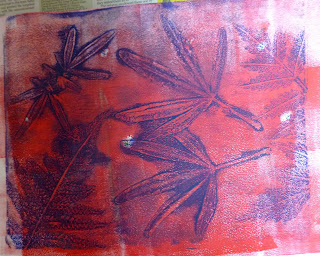So, I thought, okay time to see what this gelli plate malarkey is all about.
Went out and got myself some vegetation and put together some mark making tools.
It wasn't as easy as it looks! It needs a bit of practise and organisation. Here are a couple of things that I learnt from my first run:
- Don't use copier paper. It buckles and there is nothing more soul destroying (particularly with this craft) than getting a decent print on a lousy piece of paper. It also tends to stick to the plate if the paint has dried a bit. Instead I used a 50 sheet pad of cartridge 120gsm and it worked nicely.
- Expect that there is only going to be 1 good print for every 5 bad although I hope with practice this will improve!
- When you clean your plate, do the final dry with a fabric cloth/towel. The first time, I patted a paper towel on it for the final dry and took the next 10 minutes trying to scrap it off!
- Don't use paper stencils. Again, horrible to get off the gel plate and in the meantime the paint has dried so you don't get a ghost print. Also, fatally I used a paper stencil with a previous layer that was wet and couldn't get it off my original - gutted. I had some acetate stencils that I made some while back and they worked great.
- I found that a smaller brayer worked better than a big one but might just be me.
- I tended to clean the plate inbetween prints because otherwise the previous layer sometimes dried and you don't get crisp mark making.
The second and fifth are ghost prints and on the fifth you can see the white scratch marks caused by trying to get the paper stencil off the plate.
Ah, but the big thing for me is using them in Photoshop Elements. I took a picture of the leaves that I had used because they looked so pretty:
And then I blended this photo with the third and sixth prints to get these manipulations (also changed the levels and colours). Some of them would probably look better in portrait:













Thanks so much for sharing your results with Gelli plate printing. I also have a Gelli plate sitting in my cupboard waiting for a day when I can experiment and I'm sure your tips will be very handy. I love what you did with your prints in PSE. Oh, the possibilities are endless!!
ReplyDeleteI’m not sure what you mean by blending them in photoshop elements. Could you explain the process a bit more? Thanks
ReplyDelete